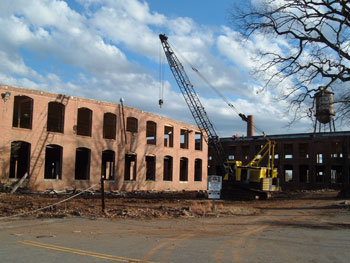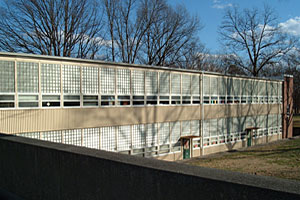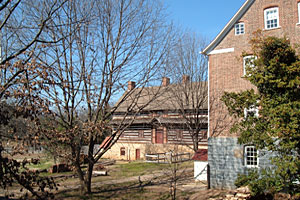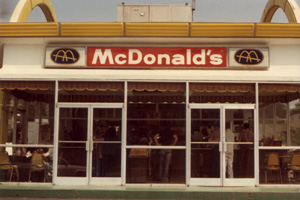(Originally published in the now-defunct Twin City Sentinel.)
They’re going to tear down Moore School on Knollwood Street. Funny thing is no one seems to care, even here in presevation-minded Winston-Salem? How can this be, you ask?
How indeed?
An unfortunate truth in Winston-Salem, just as in most other places, is that “historic presevation” all too often means “preservation of cute buildings that look really old, no matter when they were actually built.” If this school had been built twenty years earlier in some faux Colonial motif, people would be falling all over each other trying to save it. But a unique and significant modernist structure — something with a style that was actually current at the time when it was built, heaven forbid — doesn’t stand a chance.
Evidently, historic preservation looks like this:
But not like this:
You might be interested to discover that there’s a very good chance that the second building in the sequence (a 1950s style McDonald’s on Corporation Parkway, demolished in the 1980s) may actually be older than one of the structures in the first photo.
You see, the first two buildings are from the Old Salem restoration project, a “living history” museum featuring several pre-1850 buildings and probably almost as many reconstructions of pre-1850 buildings. Like Colonial Williamsburg, Old Salem was once an integral part of Winston-Salem, with buildings of varying ages and styles. Many very old structures had been spared the wrecking ball since a large part of the neighborhood was owned by the Moravian Church. However, many of these buildings had been altered over time, and there was also significant infill.
Starting in the 1950s, Old Salem went the “historic district” route, with an appearance commission, restrictive covenants, and more. Very simply, it became a museum, the goal of which was to obliterate any evidence that time had passed. As such, it became impossible to tear anything down in the historic district. Impossible, that its, unless it happened to be a structure built after about 1850. In that case, any building, no matter how architecturally significant, could, and in fact would eventually be destroyed. In addition, any changes made to the exteriors of these buildings were removed, leaving (in many cases) little but new construction based on old pictures and plans.
I call it the “sledgehammer approach” to historic preservation. While the practitioners’ hearts may have been in the right place, this approach has been almost as destructive as the 1960s urban renewal programs were. It’s taken what could have been one of the most interesting neighborhoods in Winston-Salem and turned it into something of a dead zone, trapped in time, with no hope of escape or evolution. Unless you’re a resident (which means you kicked in some serious cash), or on a field trip, or doing research, or showing it to visitors, there’s really no compelling reason to go to Old Salem. It’s very cute and scenic and photogenic, but there’s just not much going on there.
I don’t like historic districts that have been turned into museum exhibits, stripped of any temporal context or change. Most aren’t as severe a case as Old Salem, but once the designation is applied, almost any such district takes on a certain pretentious aura, its residents trying to apply a past most urban neighborhoods never really had in their heyday, with imitation gaslights and decorative street signs, and overpriced paving stones.
And every house must be from the same decade, dammit. Or at least must look the part. By the way, only houses are allowed to begin with.
I now present my own rules for historic preservation, the ones that will take effect when I am declared emperor:
- History did not end at the turn of the last century. Many important things have happened since then, and many of these things happened in equally important buildings that were built since then.
- Neighborhoods and cities change over time. Single-era neighborhoods are generally a trifle boring when all is said and done. To ignore evolution is not to preserve history, but to deny it.
- Buildings change over time as well. The 1950s modern façade that was added to the lower level of the 1920s office building is as much a part of that building’s history as is the original façade, and sometimes more. Additions and modifications should at least be considered for preservation, and not be automatically dismissed.
- Commercial buildings, even small ones that may have contained mundane things like grocery and drug stores, are every bit as worthy of preservation (if not more so) than grand structures that most “common people” never visited when they were new. These “everyday” structures are the ones people remember, and can often tell us much more about life in the past than some mansion on a hill.
- Priority should go to (a) buildings that are unique, (b) buildings that can be rehabilitated for some useful purpose, (c) buildings that have some physical relationship to the time in which they were built, and (d) buildings where something important happened — although my definition of “important” may differ from yours.
My first job in San Francisco was at a Kinko’s location adjacent to Stonestown Mall in the Sunset District. I’d transferred there from my old store in North Carolina, and it seemed a good way to get on my feet. Working in the Sunset also gave me a perspective on San Francisco not experienced by most young newcomers who arrive looking for that whole “urban thing.”
The Sunset is a strange hybrid of urban and suburban on the southwest side of San Francisco. Parts of it, most of them closer in and referred to as the “Inner Sunset,” developed from 1900 to 1920, but a large part of the area dates from after World War II. Unlike the crowded areas east of Twin Peaks, where rowhouses and apartment buildings are the standard mode of housing, single-family detached structures predominate in most of the Sunset. Thus, the area tends to be more family-oriented and somewhat more conservative than the rest of the city. The growing Asian population in the area has not changed this tendency at all.
Most “downtowners” view the Sunset as alien territory, full of everything they fled Des Moines or Houston or Raleigh to escape. Of course, they also have no real idea what they’re talking about, since most of them have never spent any appreciable time in the Sunset, nor the Outer Mission. Many folks whole live west of Twin Peaks and north of Bernal Heights don’t get out much, and it shows; they’re convinced that anything outside their little 15-20 square mile area is full of nothing but Wal-Mart stores and gun-toting Klansmen.
I got to know the Sunset fairly well during my years in San Francisco, starting from a strong foundation built while working at that Kinko’s branch. I’ll admit that it was a bit of a culture shock to move between the somewhat more sedate world of the Sunset and my South of Market home world of bars and sex clubs and live music and general chaos. The first thing I noticed was th fog, which I, of course, loved. Then I noticed that there were actually children and old people around; everyone wasn’t somewhere between 20 and 35. People in the Sunset had houses and jobs and drove cars, and didn’t brag about having managed to qualify food stamps like several trendoids I met South odf market did. People shopped at the Emporium or in Daly City rather than at trendy little overpriced boutiques, and there were actually supermarkets other than Safeway or Cala.
I didn’t particularly want to live there; my take was that the Sunset had too many of the negatives of both urban and suburban living and too few of the positives. For example, it was almost as expensive as more central parts of San Francisco, but generally lacked the pedestrian scale, neighborhood stores, etc. And I still think that’s true of many of its neighborhoods, although I later came to be very find of both the West Portal and Irving Street areas, not to mention the full length of Taraval Street. Interestingly enough, these also happen to be the only major transit corridors in the Sunset.
But I found the people I met there to be an interesting, if slightly quirky bunch. The Sunset has a much higher proportion of native San Franciscans (or at least it did in the early 1990s) and I noticed that many felt surprisingly little connection the the city. One of my coworkers, a 20-year-old who was born and raised in the Sunset, regularly went to San Jose for nightlife, saying there was “nothing for me to do in San Francicso.” And it’s true, I guess. He was black, heterosexual, not into the whole technohousedance thing nor the fashion scene, and I imagine he probably would’ve felt rather out of place in San Francisco’s over-hyped and overpriced clubs.
Compared to “downtown” San Francisco, the Sunset is less white, less transient, less fashionable, less gay, more politically moderate, and more diverse with respect to age (and increasingly even ethinicity). It’s not a bad place. It’s a pity more San Franciscans have never visited it. I’m glad I did.

This was a pretty sad sight I wasn’t really expecting to see today. They’re tearing down the old Pomona Mill in Greensboro. This was less than two miles from the house where I grew up, so it’s a landmark I used to pass pretty much every day, and one that I’ll definitely miss.
By the time I was born, the building was being used as a Western Electric plant. By the time I was in high school, it had been converted into an outlet mall that never quite took off; that closed probably ten to fifteen years ago. The building had pretty much been vacant since then, I believe.
As far as I can tell, there aren’t any plans for the land. It’s in sort of an awkward location which isn’t really appropriate for retail, and the surrounding neighborhood isn’t sufficiently picturesque for it to be converted into lofts for the “faux urban” crowd. I imagine they’re tearing it down because they think the land may sell quicker that way, and they’re probably right.
All the same, I can’t imagine what they might build in its place, and I’m sure going to miss my old mill.
Bolland
You’re in the Army Now, 1982
In their home country, they were known as Bolland & Bolland, and they actually had hits. In the US, it was simply Bolland, and three or four people bought their album “The Domino Theory”. I was one of them.
Just by way of a plug, there’s new content over at the Twin City Sentinel. It’s been kind of a slow start, and Mark’s been adding more stuff than I have, but we seem to have finally found our format: sort of an unrban journal, with an emphasis — but not an exclusive focus — on this area.
Ultravox
Dancing with Tears in My Eyes, 1984
Most. Depressing. Video. Ever.
Camper Van Beethoven
Take the Skinheads Bowling, 1985
I got to know one of the former Campers Van when I lived in San Francisco and developed a very slight crush on him. At the time, I found it very cute that a jaded old soul like myself actually could still get crushes, particularly ones that I didn’t even act on.
The Way
Fastball, 1997
I dunno. I just always liked this song. And it was getting lots of airplay around the time of the Planet SOMA US Tour 1997, so I associate it with being intersting places I was seeing for te first time.
Sniff and the Tears
Driver’s Seat, 1979.



